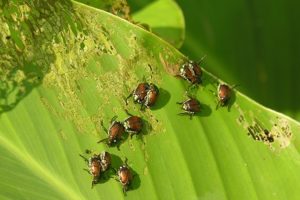 A well-defined Integrated Pest Management (IPM) Program is based on prevention, monitoring, and control that will eliminate or drastically reduce the use of pesticides. Reducing pesticides will minimize the toxicity of and exposure to any products which are used in pest control. IPM does this by utilizing a variety of methods and techniques, including cultural, biological and structural strategies to control a multitude of pest problems. Integrated pest control is a multi-pronged strategy that methodically addresses pest issues at various levels. The key steps for incorporation of IPM into your landscaping maintenance are…
A well-defined Integrated Pest Management (IPM) Program is based on prevention, monitoring, and control that will eliminate or drastically reduce the use of pesticides. Reducing pesticides will minimize the toxicity of and exposure to any products which are used in pest control. IPM does this by utilizing a variety of methods and techniques, including cultural, biological and structural strategies to control a multitude of pest problems. Integrated pest control is a multi-pronged strategy that methodically addresses pest issues at various levels. The key steps for incorporation of IPM into your landscaping maintenance are…
Identifying Pests
This is the first thing that needs to be done. Monitor and identify the pest on your property. It is not fun to find that part of your garden disappeared while you slept. Discovering leaves that looked fine yesterday were munched on overnight. Or from realizing that flower buds you’ve been waiting to open are completely gone. You need to narrow down the environmental factors that impact the pest growth and proliferation.
Taking Action Against Pests
Pests are virtually never eradicated. An action level is the population size which requires remedial action for human health, economic, or aesthetic reasons. Preventive measures must be incorporated into the existing structures and designs for new structures. Prevention is and should be the primary means of pest control in an IPM program. It helps to determine whether your grass plants, shrubs, and trees can tolerate and treat on their own or will they need intervention to fight the infestation of pest.
Responding to the Pests
If immediate attention is needed a combination of biological, cultural, physical, and chemical control measures to keep your landscape free of pest insects and vermin must be done. Under IPM, chemicals should be used only as a last resort only, but when used, the least-toxic materials should be chosen, and applied to minimize exposure to humans and all non-target organisms.
Integrated Pest Management Control Tactics
- Biological – This is a strategy when pests kills pests. Use of insecticides that contain microorganisms that are natural enemies of the targeted pest.
- Cultural – These measures focus on reducing the pests establishment and reproduction as well as their spread and survival. There are many practices that make the environment less favorable to insect pests. Examples – include cultivation of alternate hosts .plant rotation, selection of planting sites, trap crops, and adjusting the timing of planting
- Physical – Methods include hand picking of pests, sticky boards or tapes for control of flying insects in greenhouses and various trapping techniques such as traps for rodents.
- Chemical – When all other methods fail… use synthetic pesticides sparingly. Find a spray that is safe for the air, soil, water, humans, and pets.
Focus on growing healthy pest resistant plants and turf by the integrating a pest control process. Protect your landscape and property and have long term prevention of pests and pest damage.
Is your property not receiving the attention it deserves? Are you tired of overpaying for subpar service? First Green Landscaping provides the best value for professional lawn care and landscaping services in the Cincinnati / Northern Kentucky area. No property is too big or too small for First Green Landscaping.
Contact us (859-292‐8556) today for a free consultation!
—
 About First Green Commercial Landscaping
About First Green Commercial Landscaping
First Green Commercial Landscaping is a locally owned leading provider of lawn care and landscaping services in the Cincinnati / Northern Kentucky area. We provide superior customer service and strive to build long term business relationships with our clients.
- Lawn Care
- Landscape Maintenance
- Snow Removal
>> Learn More

 About First Green Commercial Landscaping
About First Green Commercial Landscaping